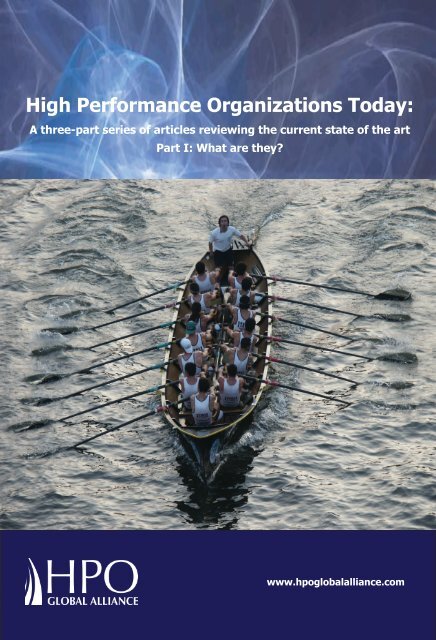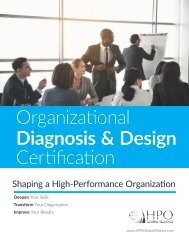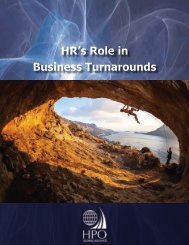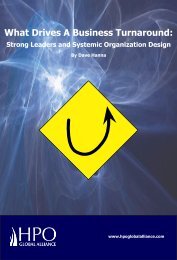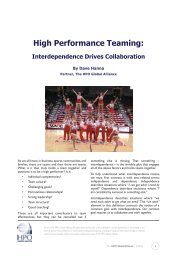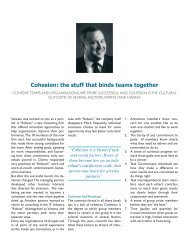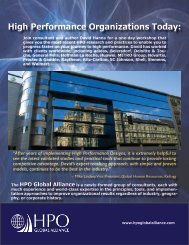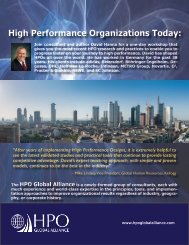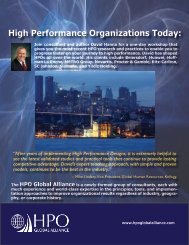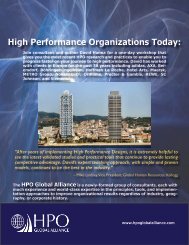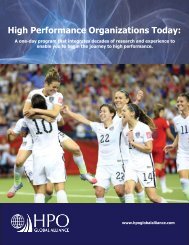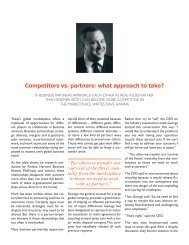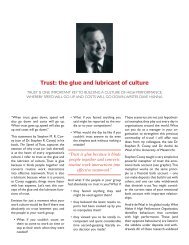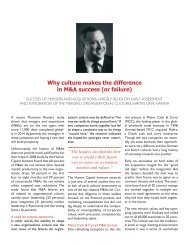HPOs Today Part 1 magazine
Part 1 of a series of articles that defines the latest views on what makes a High Performance Organization (HPO). This part focuses on the global study that validates HPO key factors. It includes case examples of Ritz-Carlton and Toyota as HPOs.
Part 1 of a series of articles that defines the latest views on what makes a High Performance Organization (HPO). This part focuses on the global study that validates HPO key factors. It includes case examples of Ritz-Carlton and Toyota as HPOs.
Create successful ePaper yourself
Turn your PDF publications into a flip-book with our unique Google optimized e-Paper software.
High Performance Organizations <strong>Today</strong>:<br />
A three-part series of articles reviewing the current state of the art<br />
<strong>Part</strong> I: What are they?<br />
www.hpoglobalalliance.com<br />
The HPO Global Alliance ©2015<br />
1
HIGH PERFORMANCE<br />
ORGANIZATIONS TODAY:<br />
A three-part series of articles reviewing the current state of the art<br />
<strong>Part</strong> I: What are they?<br />
Leaders today are seeking guidance on how to survive<br />
and thrive in an ever-evolving global marketplace.<br />
CONTEXT<br />
Fads come and go. Good ideas ebb and flow. We<br />
return – again and again – to principle-based<br />
concepts that can solve dilemmas in any situation<br />
and era as time moves on. The latter is the case with<br />
the dynamics of High Performance Organizations<br />
(<strong>HPOs</strong>).<br />
<strong>HPOs</strong> were talked about, written about, and<br />
attempted in many organizations in the 1980s and<br />
‘90s. Their popularity waned for a time, but the<br />
concept is making a comeback.<br />
Much has happened in the world of organizations<br />
since the ‘80s and ‘90s. Many new developments<br />
have helped all of us move to higher ground in the<br />
HPO journey. The Quality approach of W. Edwards<br />
Deming explained why Japanese competitors<br />
were beating their American counterparts in the<br />
marketplace. Deming’s legacy has continued through<br />
Michigan professor Jeff Liker, who has shown us<br />
The Toyota Way and its practical approaches to lean<br />
production.<br />
Peter Senge’s The Fifth Discipline reinforced the need<br />
for working on the whole system. The High Tech<br />
Age has reshaped dramatically the marketplace’s<br />
requirements for survival. Process re-engineering<br />
has influenced how many organizations approach<br />
restructuring. Jay Galbraith continued to suggest<br />
ways of designing organizations for emerging global,<br />
innovation, and high tech opportunities.<br />
Then there has been the whole flood of literature<br />
on the subject of leadership, led importantly by<br />
Stephen R. Covey with The Seven Habits of Highly<br />
Effective People, and Jeff Dyer, Hal Gregersen, and<br />
Clayton Christensen with The Innovator’s DNA.<br />
Thus, today’s laundry list for things to do to create<br />
an HPO is almost endless: craft a competitive<br />
strategy; write a distinctive purpose statement;<br />
engage employees; develop work teams; champion<br />
Six Sigma; re-engineer your processes; develop<br />
principle-centered, innovative leaders; engage<br />
customers; build more trust with stakeholders;<br />
downsize; and implement lean production.<br />
But research has shown that more than 70 percent<br />
of these isolated initiatives have failed to make<br />
significant, long-lasting improvements in a company’s<br />
business results.<br />
These disappointing results have less to do with<br />
the initiatives themselves than with the singleshot<br />
approach taken by leaders and organizational<br />
designers. Significantly shifting a business<br />
organization’s results requires a whole systems<br />
approach. After all that has been said and done<br />
about a systems approach to organizing, much more<br />
has been said than done.<br />
<strong>HPOs</strong> TODAY<br />
The purpose of this paper is to give a fresh look<br />
at <strong>HPOs</strong> based on the many developments through<br />
the years. We propose a whole systems framework<br />
for viewing and managing an organization in today’s<br />
rapidly changing global marketplace – a framework<br />
that describes <strong>HPOs</strong> today.<br />
The most significant development in recent years<br />
is the research of more than 2,500 companies conducted<br />
by Dr. André de Waal of the University of<br />
Maastricht in The Netherlands. André has research<br />
for more than a decade what makes a HPO. He has<br />
learned that <strong>HPOs</strong> are characterized by the following<br />
factors:<br />
1. High quality management: decisive,<br />
action oriented, strong trust relationships,<br />
coaching, holding others responsible<br />
2. High quality employees: recruiting those<br />
who want to assume responsibility and<br />
excel, from diverse backgrounds; who are<br />
complementary, flexible, and resilient.<br />
3. Long-term orientation: continuity over<br />
© 2015 The HPO Global Alliance. All rights reserved. No part of this publication may be reproduced or transmitted in<br />
any form or by any means, electronic or mechanical, including photocopying, recording, or using any information storage or<br />
retrieval system, for any purpose without the express written permission of The HPO Global Alliance.
short-term profit, collaboration with others,<br />
good long-term relationships with all<br />
stakeholders, focus on customers.<br />
4. Continuous improvement and<br />
innovation: a distinctive strategy; processes<br />
that are continuously improved, simplified,<br />
and coordinated; core competencies and<br />
products continuously improved; reporting<br />
important and correct information.<br />
5. Open and action-oriented management:<br />
communicating often with employees, open<br />
to change, performance oriented, engaging<br />
in dialogue with others.<br />
These factors are not just André de Waal’s preferred<br />
attributes. An analysis of the Big Data from<br />
organizations in all parts of the world, both large and<br />
small, both public and private, the companies who<br />
met the five profile factors also had these financial<br />
advantages compared to other companies in the<br />
study who did not meet the profile:<br />
Type of financial return Return of HPO vs. peer<br />
group (in %))<br />
Revenue growth +4 to 16<br />
Profitability +14 to 44<br />
Return on assets (ROA) +1 to 12<br />
Return on equity (ROE) +9 to 25<br />
Return on investment +15 to 26<br />
(ROI)<br />
Return on sales (ROS) +2 to 18<br />
Total shareholder<br />
+4 to 42<br />
return (TSR)<br />
Just as significant as André’s learning about what<br />
makes a high performance organization was what<br />
he learned does not necessarily correlate with<br />
high performance. Here are some of the common<br />
techniques, methods, and activities that do not<br />
guarantee high performance:<br />
• Defining a clear vision, mission, and strategy<br />
• Enhancing trust in leadership<br />
• Putting more focus on customers<br />
• Changing organizational structure<br />
• Introducing servant leadership<br />
• Laying off poor-performing employees<br />
• Creating more two-way communication<br />
• Lowering work pressures<br />
• Creating better career opportunities<br />
• Improving listening skills in management<br />
Put another way, organizations in André’s research<br />
might have done one or more of these things but<br />
still did not qualify as <strong>HPOs</strong>. If these well-intentioned<br />
activities did not lead to establishing the five HPO<br />
factors, the company’s results were no different<br />
from the other non <strong>HPOs</strong>.<br />
To recap: single shot or isolated interventions seldom<br />
are able to drive and sustain high performance in<br />
complex organizations.<br />
THE LOOK AND FEEL OF <strong>HPOs</strong><br />
Let’s consider two shining examples of what <strong>HPOs</strong><br />
look like to the customer.<br />
The Ritz-Carlton Hotel Company is a consistent<br />
leader in the hotel industry and the only two-time<br />
winner of the Baldrige National Quality Award in<br />
the service industry. If you were to enter one of<br />
its 87 hotels in 29 countries, you would be greeted<br />
immediately by a friendly face and escorted to the<br />
front desk. An employee would guide you to your<br />
room and demonstrate the room’s comfortable<br />
features and answer any questions you might have.<br />
The room and its furnishings would be luxuriously<br />
comfortable and impeccably clean. If you had stayed<br />
at any Ritz-Carlton in the past and had indicated<br />
a preference for certain things such as fresh fruit,<br />
feather pillows, black ink in the room’s pens, or<br />
reading material, these would all be waiting for you<br />
in your room.<br />
Ritz-Carlton restaurateurs prepare for guests<br />
You would be impressed further by the prompt,<br />
friendly service with every interaction you had with<br />
the ladies and gentlemen in the hotel. And if you<br />
had a special need (special dietary requirement in<br />
the restaurant, misplaced handbag, or even a torn<br />
zipper on your clothing) you would be amazed<br />
at how creatively and quickly the Ritz-Carlton<br />
family members would solve your problem. You<br />
would experience them offering to take care of<br />
even your unexpressed wishes. Every meal, every<br />
recommendation, every service provided would be<br />
excellent.<br />
Upon departure, your hosts would go to great<br />
lengths to anticipate or inquire about other<br />
arrangements you might need, from reading material<br />
for the ride to the airport, to special transport<br />
The HPO Global Alliance ©2015<br />
3
home of baggage or packages you didn’t want to<br />
take to your next stop, to reservations at another<br />
hotel (not necessarily a Ritz-Carlton). Small wonder<br />
that Ritz-Carlton leads the way with a customer<br />
engagement score of above 90 percent according to<br />
Gallup polls. You would mark down this brief hotel<br />
stay as a memorable experience indeed!<br />
A totally different atmosphere would await you<br />
if you toured a Toyota Production Facility in<br />
Japan. No fancy furniture or gourmet meals here.<br />
Just an amazing production operation with skilled<br />
associates who could perform their task on the<br />
assembly line without skipping a beat. There would<br />
be no huge stacks of materials or boxes of parts<br />
obscuring your view of the many production lines,<br />
yet almost magically the necessary parts would be<br />
at the associate’s side just when he or she needed<br />
them.<br />
imagined!<br />
COMMON HPO PRINCIPLES<br />
Though a superficial look at a Ritz-Carlton hotel<br />
or a Toyota production facility might suggest they<br />
are very different organizations, the deeper look<br />
would reveal they both operate on very similar<br />
principles. These principles are not just motivational<br />
concepts or automated systems. They are common<br />
organizational principles, each adapted to the nature<br />
of the work and to the market requirements for a<br />
successful hotel or automobile company. The same<br />
principles are the foundation for <strong>HPOs</strong> in any<br />
category today.<br />
These HPO principles will be reviewed in <strong>Part</strong> II.<br />
The production floor would be extremely neat and<br />
clean – no oil spills or piles of dust in the corners.<br />
No leaking valves or cables. A safe and pleasant<br />
workplace.<br />
Toyota’s lean production line<br />
The latest process innovations to the production line<br />
from the steady stream of employees’ improvement<br />
ideas would be functioning flawlessly.<br />
All of these elements combine to produce an<br />
automobile in an industry-best 30.37 hours. Toyota<br />
plants average 100% equipment utilization despite<br />
fluctuations in the market. The Toyota Corolla<br />
remains the best-selling car in the world, with 1.02<br />
million vehicles sold. The Toyota Camry, America’s<br />
best-selling car, is number eight on the worldwide<br />
sales chart with 726,000 units sold.<br />
Then, as you drove your new Toyota home and lived<br />
with it year after year, you would observe your<br />
neighbors taking their cars to the repair shop much<br />
more frequently than you did. They would have to fill<br />
up at the gas station more often. Their cars would be<br />
ready for retirement at the same time your Toyota<br />
would be entering its second childhood.<br />
You would conclude that simply buying a Toyota had<br />
enriched your life much more than you could have<br />
The HPO Global Alliance ©2015<br />
4


